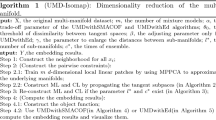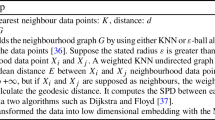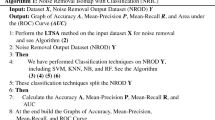Abstract
As one of the most promising nonlinear unsupervised dimensionality reduction (DR) technique, the Isomap reveals the intrinsic geometric structure of manifold by preserving geodesic distance of all data pairs. Recently, some supervised versions of Isomap have been presented to guide the manifold learning and increase the discriminating capability. However, the performance may deteriorate when there is no sufficient prior information available. Hence, a novel semi-supervised discriminant Isomap (SSD-Isomap) is proposed in the paper. First, two pairwise constraints including must-link and likely-link (LL) are used to depict the neighborhoods of data points. Then, two graphs are constructed based on the two constraints, and distances between points belonging to the LL constraint are modified by a scale parameter. Finally, the geodesic distance metric is obtained based on the graphs, and the corresponding optimal nonlinear subspace is sought. The performance of SSD-Isomap is evaluated by extensive experiments of data visualization, image retrieval and classification. Compared with other state-of-the-art DR methods, SSD-Isomap presents more accurate and robust results.





Similar content being viewed by others
References
Musa AB (2014) A comparison of ℓ1-regularizion, PCA, KPCA and ICA for dimensionality reduction in logistic regression. Int J Mach Learn Cybern 5(6):861–873
Sharma A, Paliwal KK (2015) Linear discriminant analysis for the small sample size problem: an overview. Int J Mach Learn Cybern 6(3):443–454
Cai D, He X, Han J (2008) Training linear discriminant analysis in linear time. In: IEEE 24th international conference on data engineering, Cancun, pp 209–217
Liu Y, Rong J (2006) Distance metric learning: a comprehensive survey. http://www.cs.cmu.edu/~liuy/frame_survey_v2.pdf. Accessed 6 May 2015
Belkin M, Niyogi P (2002) Laplacian Eigenmaps and Spectral Techniques for Embedding and Clustering. Adv Neural Inf Process Syst 14(6):585–591
Raducanu B, Dornaika F (2012) A supervised non-linear dimensionality reduction approach for manifold learning. Pattern Recognit 45(6):2432–2444
Roweis ST, Saul LK (2000) Nonlinear dimensionality reduction by locally linear embedding. Science 290(5500):2323–2326
Laurens VDM (2014) Accelerateing t-SNE using tree-based algorithms. J Mach Learn Res 15(1):3221–3245
Tenenbaum JB, De SV, Langford JC (2000) A global geometric framework for nonlinear dimensionality reduction. Science 290(5500):2319–2323
Silva VD, Tenenbaum JB (2003) Global versus local approaches to nonlinear dimensionality reduction. In: Advances in neural information processing systems, pp 705–712
Vlachos M, Domenicon C, Gunopulos D (2002) Non-linear dimensionality reduction techniques for classification and visualization. In: Proceeding of 8th ACM SIGKDD international conference on knowledge discovery and data mining. ACM, pp 645–651
Geng X, Zhan DC, Zhou ZH (2005) Supervised nonlinear dimensionality reduction for visualization and classification. IEEE Trans Syst Man Cybern Part B Cybern 35(6):1098–1107
Zhang Z, Chow TW, Zhao M (2012) M-Isomap: orthogonal constrained marginal isomap for nonlinear dimensionality reduction. IEEE Trans Syst Man Cybern Part B Cybern 43(1):180–191
Yang B, Xiang M, Zhang Y (2016) Multi-manifold discriminant Isomap for visualization and classification. Pattern Recognit 55:215–230
Meng M, Wei J, Wang J et al (2015) Adaptive semi-supervised dimensionality reduction based on pairwise constraints weighting and graph optimizing. Int J Mach Learn Cybern 8(3):793–805
Chen WJ, Shao YH, Hong N (2013) Laplacian smooth twin support vector machine for semi-supervised classification. Int J Mach Learn Cybern 5(3):459–468
Wang R, Wang XZ, Kwong S et al (2017) Incorporating diversity and informativeness in multiple-instance active learning. IEEEE Trans Fuzzy Syst 25(6):1460–1475
Luo Y, Tao D, Xu C (2013) Vector-valued multi-view semi-supervised learning for multi-label image classification. In: Proceeding of 27th AAAI conference on artificial intelligence, pp 647–653
Zhu S, Sun X, Jin D (2016) Multi-view semi-supervised learning for image classification. Neurocomputing 208:136–142
Zhu H, Wang X (2017) A cost-sensitive semi-supervised learning model based on uncertainty. Neurocomputing 251:106–114
Ashfaq RAR, Wang XZ, Huang JZ et al (2017) Fuzziness based semi-supervised learning approach for intrusion detection system. Inf Sci 378:484–497
Cai D, He X, Han J (2007) Semi-supervised discriminant analysis. In: IEEE 11th international conference on computer vision, pp 1–7
Yang X, Fu H, Zha H, Barlow J (2006) Semi-supervised nonlinear dimensionality reduction. In: Proceeding of 23th international conference on machine learning, pp 1065–1072
Hou V, Zhang C, Wu Y, Nie F (2010) Multiple view semi-supervised dimensionality reduction. Pattern Recognit 43(3):720–730
Zhang D, Zhou ZH, Chen S (2007) Semi-supervised dimensional reduction. In: Proceeding of the 7th SIAM international conference on data mining (SDM’07), pp 629–634
Xing EP, Ng AY, Jordan MI (2003) Distance metric learning with application to clustering with side-information. In: Advances in neural information processing systems, pp 505–512
Hoi SCH, Liu W, Lyu MR, Ma WY (2006) Learning distance metrics with contextual constraints for image retrieval. In: IEEE Computer Society conference on computer vision and pattern recognition (CVPR’06), pp 2072–2078
Xia H, Hoi SCH, Jin R, Zhao P (2014) Online multiple kernel similarity learning for visual search. IEEE Trans Pattern Anal Mach Intell 36(3):536–549
Oliveira GL, Vieira AW, Vieira AW (2014) Sparse spatial coding: a novel approach to visual recognition. IEEE Trans Image Process 23(6):2719–2731
Yang Y, Newsam S (2010) Bag-of-visual-words and spatial extensions for land-use classification. In: Sigspatial international conference on advances in geographic information systems. ACM, pp 270–279
Li F-F, Fergus R, Perona P (2004) Learning generative visual models from few training examples: an incremental bayesian approach tested on 101 object categories. In: Conference on computer vision and pattern recognition workshop, pp 178–178
Georghiades AS, Belhumeur PN, Kriegman DJ (2001) From few to many: Illumination cone models for face recognition under variable lighting and pose. IEEE Trans Pattern Anal Mach Intell 23(6):643–660
Peng X, Yu Z, Yi Z (2017) Constructing the L2-graph for robust subspace learning and subspace clustering. IEEE Trans Cybern 47(4):1053–1066
Samaria FS, Harter AC (1994) Parameterization of a stochastic model for human face identification. In: Proceedings of IEEE workshop on applications of computer vision, pp 138–142
Lecun Y, Bottou L, Bengio Y, Haffner P (1998) Gradient-based learning applied to document recognition. Proc IEEE 86(11):2278–2324
Bache K, Lichman M (2013) UCI machine learning repository. http://archive.ics.uci.edu/ml. Accessed 26 June 2016
Yu J, Tao D, Li J (2014) Semantic preserving distance metric learning and applications. Inf Sci 281:674–686
Wu P, Hoi SCH, Zhao P, Miao C, Liu Z. Y (2016) Online multi-modal distance metric learning with application to image retrieval. IEEE Trans Knowl Data Eng 28 (2):454–467
Author information
Authors and Affiliations
Corresponding author
Rights and permissions
About this article
Cite this article
Huang, R., Zhang, G. & Chen, J. Semi-supervised discriminant Isomap with application to visualization, image retrieval and classification. Int. J. Mach. Learn. & Cyber. 10, 1269–1278 (2019). https://doi.org/10.1007/s13042-018-0809-6
Received:
Accepted:
Published:
Issue Date:
DOI: https://doi.org/10.1007/s13042-018-0809-6




